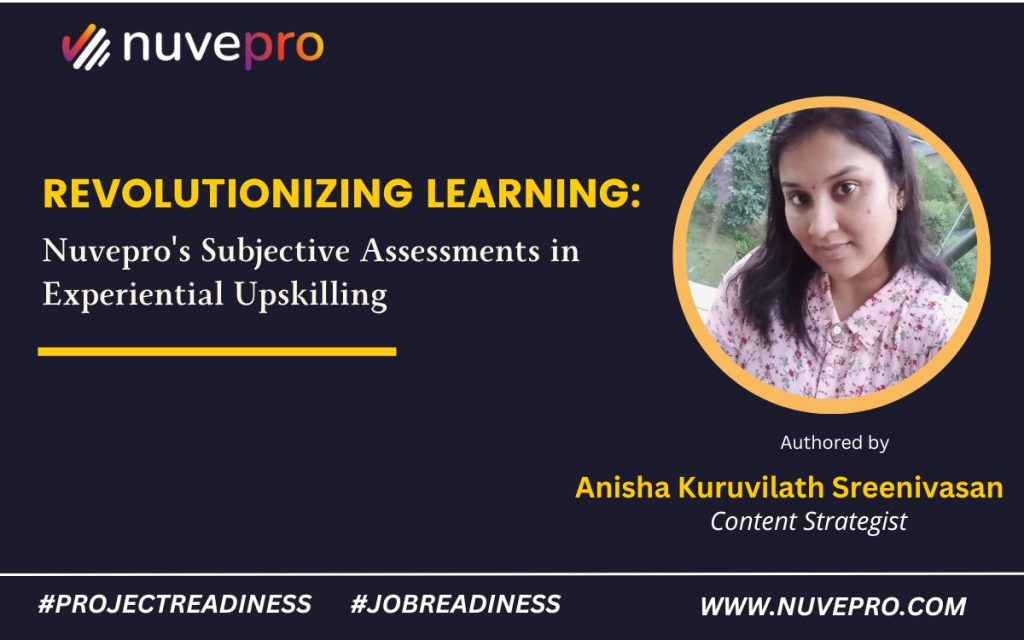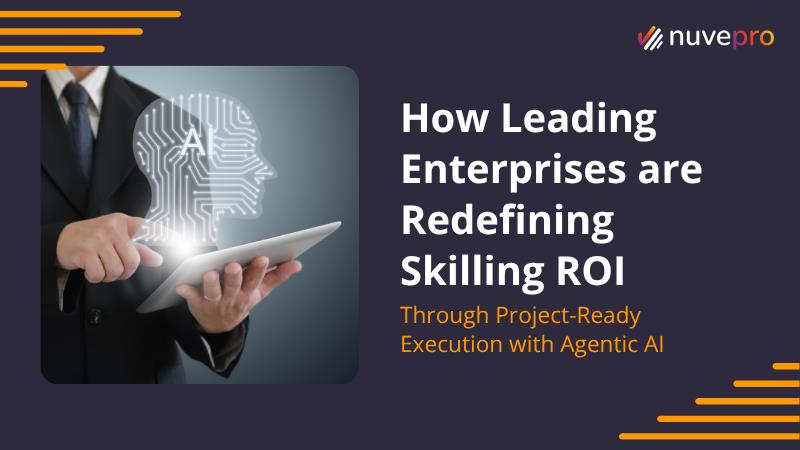Nuvepro’s Vision for Upskilling Excellence
In the fast-paced world of technology and innovation, the need for upskilling has never been more crucial. Nuvepro, an upskilling-based start-up, has stepped up to the challenge by introducing revolutionary customized skill bundles through its Hands-On Labs. These skill bundles not only redefine experiential learning but also reshape the assessment landscape. In this detailed exploration, we delve into the transformative impact of Nuvepro’s subjective assessments, spotlighting their role in bridging the gap between theoretical knowledge and practical skills.
The Nuances of Nuvepro’s Subjective Assessments
Traditional assessments have long been the cornerstone of education, excelling in evaluating theoretical knowledge. However, when it comes to the multifaceted realm of experiential learning, these assessments often fall short, unable to capture the nuances of practical skills and real-world experiences. This discrepancy prompts a fundamental question: How can we effectively assess the vital skills acquired through experiential learning?
Nuvepro’s subjective assessments emerge as a beacon of innovation in addressing this critical gap. These assessments serve a dual purpose: evaluating the learning journey itself assessing the tangible outcomes, and making the learners/ employees upskilled to become job ready/ project ready. Unlike traditional assessments that focus solely on knowledge acquisition, Nuvepro’s approach recognizes the importance of practical application and holistic skill development.
Key Advantages of Nuvepro’s Subjective Assessments
- Actionable Feedback for Educators: Nuvepro’s subjective assessments empower educators with actionable insights. By evaluating learners’ prior knowledge, learning processes, and knowledge acquired post-activity, educators can dynamically adapt teaching methods to cater to diverse student needs and learning styles. This adaptive approach optimizes the overall learning experience.
- Real-world Skill Acquisition: Beyond the mere measurement of learning outcomes, Nuvepro’s assessments provide a unique platform for students to reflect on their experiences. This reflection goes beyond theoretical understanding, delving into crucial real-world skills such as problem-solving, and ethical decision-making—skills indispensable for success in future careers.
- Enhanced Engagement and Motivation: Actively involving students in the assessment process becomes a catalyst for increased engagement and motivation. Nuvepro’s subjective assessment approach recognizes that active participation in the assessment process fosters a deeper connection with the learning material.
- Measurable Success for Institutions: Nuvepro’s subjective assessments offer more than just individual student evaluation—they provide institutions with a tangible way to measure and showcase the success of their programs. These assessments become concrete evidence of the effectiveness of experiential learning in preparing learners/ employees for the challenges of the real world.
Addressing Challenges in Experiential Learning Assessment
While the advantages of subjective assessments are clear, challenges persist in the realm of experiential learning assessment. Data contamination and deficiency pose significant hurdles. To overcome these challenges, Nuvepro advocates for a proactive approach.
Strategies to Overcome Challenges
- Comprehensive Assessment Models: Institutions should focus on developing comprehensive assessment models with clear guidelines for measuring experiential learning outcomes. These models should be informed by best practices and insights from experts, ensuring a robust framework for evaluation.
- Faculty Training and Development Programs: Recognizing that some faculty and staff may lack formal training in developing measurable learning outcomes, institutions should invest in comprehensive training and development programs like Nuvepro’s skill bundle and engage them in subjective assessments to measure their skill levels. These programs focus on enhancing skills in creating measurable and valid learning outcomes, aligning curriculum with these outcomes, and devising appropriate assessment tools and methods.
- Regular Evaluation and Refinement: To minimize data contamination and deficiency, institutions should adopt a culture of regular evaluation and refinement of assessment strategies. This ongoing process ensures that assessments stay aligned with the evolving landscape of experiential learning.
Unveiling Nuvepro’s Skill Bundles: A Holistic Learning Experience
Nuvepro’s commitment to effective learning goes beyond assessments and extends into its Skill Bundles—carefully curated to provide learners with a seamless and engaging learning experience. These Skill Bundles are designed to offer multiple projects, allowing learners to practice and apply their skills in different contexts.
Exploring Nuvepro’s Skill Bundles: A Structured Approach to Practical Proficiency
1. Conceptual Project: Integrated Learning in the Playground Lab
Commencing our journey through Nuvepro’s Skill Bundles, we first delve into the Conceptual Project—a sophisticated learning module seamlessly integrated into the Playground Lab. This component represents an amalgamation of didactic video content and instructor-led programs, complemented by unhindered access to instructional materials during practical exercises. Distinctively, learners/employees are afforded the opportunity for the simultaneous application of acquired concepts. This ensures not only a theoretical understanding but also a profound mastery of the practical implications. Whether engaged with expert-led sessions or educational videos, the Conceptual Project serves as a foundational pillar for immersive skill application.
2. Guided Project: Systematic Skill Development Through Interactive Exploration
The Guided Project follows suit, providing learners with a dedicated space within the Playground Lab designed for interactive exploration. Herein, learners encounter meticulously designed exercises, each with specific objectives aimed at fostering a hands-on approach to skill mastery. Going beyond traditional learning paradigms, this component transforms the educational journey into a personalized expedition. Through hands-on and interactive exercises, learners receive immediate feedback, rendering each task an integral step toward skill mastery. The Guided Project is more than an assignment; it is a structured journey towards honing essential skills.
3. Assessments: Applied Challenges in a Secure Learning Environment
Subjective assessments emerge as the pinnacle of Nuvepro’s Skill Bundles, designed for programs wherein practical application holds paramount importance. These assessments prompt learners to apply their knowledge within specific scenarios or chosen skills, mirroring real-world challenges. Unfolding as problem statements within the secure confines of the Playground Lab, these assessments provide learners with simulated professional challenges. It becomes a controlled environment for the development of practical skills, offering a risk-free space for learners to experiment with diverse approaches. The assessments transcend the traditional examination concept; they stand as opportunities for learners to navigate challenges and emerge with a heightened proficiency.
Mastering Assessments with Nuvepro’s Hands-On Labs:
As the learning landscape evolves, Nuvepro’s Hands-On Labs stand as a testament to innovation. Auto-graded assessments provide near-instantaneous feedback, covering a wide spectrum of technologies from Cloud and DevOps to emerging fields like Cyber Security, Blockchain, and AI/ML.
Customized Learning: Nuvepro’s Breadth of Technologies:
Nuvepro’s comprehensive library encompasses assessments tailored to various technologies, including Data Science, Azure, GCP, JAVA, MERN, ASP.NET, SQL, Role Path, Snowflake, Mobile Android Development, Docker, Kubernet Selenium-SDET, AWS, DevOps, Python, Data Analysis, Cybersecurity, and over 1000 more. This diverse range ensures learners are equipped with skills aligned with the demands of the ever-evolving industry.
Nuvepro is the new Experiential Learning Ally
In conclusion, Nuvepro’s foray into experiential learning and assessment with its revolutionary Skill Bundles and Subjective Assessments signifies a transformative shift in the education technology landscape. By seamlessly integrating theoretical understanding with practical proficiency, Nuvepro’s assessments bridge the gap between traditional evaluations and the dynamic requirements of real-world skills. The advantages of Nuvepro’s subjective assessments, including actionable feedback for educators, real-world skill acquisition, enhanced engagement, and measurable success for institutions, underscore the platform’s commitment to holistic learning. Overcoming challenges through comprehensive assessment models and faculty training programs, Nuvepro envisions a future where learners not only acquire knowledge but also master the skills to make them job-ready/project-ready for taking up the challenges seamlessly. The structured approach of Nuvepro’s Skill Bundles, encompassing the Conceptual Project, Guided Project, and Subjective Assessments, further reinforces a commitment to providing learners with a comprehensive and engaging educational journey. Ultimately, choosing Nuvepro means embarking on a pathway to excellence, where learners master skills that define success in the ever-evolving technology-driven landscape, setting the stage for a future of continuous growth and innovation.




